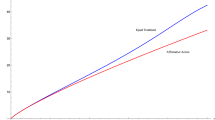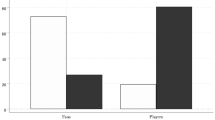Abstract
We study Tullock contests with n symmetric players. We show that in a contest without an exit option, if prizes and punishments (negative prizes) have the same cost, it is optimal for the designer who wants to maximize the players’ total effort to allocate the entire prize sum to a single punishment without any prize. On the other hand, in a contest with an exit option, it is optimal to allocate the entire prize sum to a single prize and a single punishment, where independent of the costs of the prize and the punishment, the optimal value of the prize is larger than the optimal value of the punishment. We also show that allocating a prize and a punishment in a two-stage contest yields a higher expected total effort than in a one-stage contest.
Similar content being viewed by others
Notes
Several studies have provided axiomatic justification for this contest form (see, for example, Skaperdas 1996). In addition, Baye and Hoppe (2003) have identified conditions under which a variety of rent-seeking contests, innovation tournaments, and patent-race games are strategically equivalent to this contest.
For the literature on the optimal prize allocation in rank-order tournaments, see, for example, Lazear and Rosen (1981), Green and Stokey (1983), Nalebuff and Stiglitz (1983), and Akerlof and Holden (2012). For the literature on the optimal prize allocation in all-pay auctions, see, for example, Barut and Kovenock (1998), Moldovanu and Sela (2001, 2006), and Cohen and Sela (2008).
Fu et al. (2014) found a similar result in their study of a reverse Tullock contest in which the lowest prize is allocated first, then the second lowest prize is allocated, and this continues until the highest prize is allocated.
For example, Cohen et al. (2018) showed that a two-stage Tullock contest yields a higher expected total effort than the one-stage Tullock contest. On the other hand, according to Groh et al. (2012), the total effort in a two-stage elimination all-pay auction is smaller than in the one-stage all-pay auction.
References
Akerlof R, Holden R (2012) The nature of tournaments. Econ Theory 51(2):289–313
Barut Y, Kovenock D (1998) The symmetric multiple prize all-pay auction with complete information. Eur J Polit Econ 14:627–644
Baye M, Hoppe H (2003) The strategic equivalence of rent-seeking, innovation, and patent-race games. Games Econ Behav 44(2):217–226
Berry SK (1993) Rent-seeking with multiple winners. Public Choice 77(2):437–443
Clark D, Riis C (1996) A multi-winner nested rent-seeking contest. Public Choice 77:437–443
Clark D, Riis C (1998) Influence and the discretionary allocation of several prizes. Eur J Polit Econ 14(4):605–625
Cohen N, Maor G, Sela A (2018) Two-stage elimination contests with optimal head starts. Rev Econ Des 22:177–192
Cohen C, Sela A (2008) Allocation of prizes in asymmetric all-pay auctions. Eur J Polit Econ 24:123–132
Fu Q, Lu J, Wang Z (2014) Reverse nested lottery contests. J Math Econ 50:128–140
Green J, Stokey N (1983) A comparison of tournaments and contracts. J Polit Econ 91(3):349–364
Groh C, Moldovanu B, Sela A, Sunde U (2012) Optimal seeding in elimination tournaments. Econ Theory 49:59–80
Kamijo Y (2016) Rewards versus punishments in additive, weakest-link, and best-shot contests. J Econ Behav Org 122:17–30
Lazear E, Rosen S (1981) Rank-order tournaments as optimum labor contracts. J Polit Econ 89(5):841–864
Moldovanu B, Sela A (2001) The optimal allocation of prizes in contests. Am Econ Rev 91:542–558
Moldovanu B, Sela A (2006) Contest architecture. J Econ Theory 126(1):70–97
Moldovanu B, Sela A, Shi X (2012) Carrots and sticks: prizes and punishments in contests. Econ Inq 50(2):453–462
Nalebuff B, Stiglitz J (1983) Prizes and incentives: towards a general theory of compensation and competition. Bell J Econ 14(1):21–43
Rosen S (1986) Prizes and incentives in elimination tournaments. Am Econ Rev 76:701–715
Schweinzer P, Segev E (2012) The optimal prize structure of symmetric Tullock contests. Public Choice 153(1):69–82
Skaperdas S (1996) Contest success functions. Econ Theory 7:283–290
Tullock G (1980) Efficient rent seeking. In: Buchanan JM, Tollison RD, Tullock G (eds) Toward a theory of the rent-seeking society. Texas A&M University Press, College Station, pp 97–112
Author information
Authors and Affiliations
Corresponding author
Additional information
Publisher's Note
Springer Nature remains neutral with regard to jurisdictional claims in published maps and institutional affiliations.
Appendices
Appendix
1.1 Proof of Proposition 1
The F.O.C. of (1) and (2) yields
By symmetry, \(x=y,\) and then we obtain
where \(H_{n}=\sum \nolimits _{i=1}^{n}\frac{1}{i}\) is the harmonic series. Similarly, by symmetry, \(x=y,\) and then
This implies that
Inserting (18) and (19) in (17) yields
Hence, the players’ symmetric equilibrium effort in a contest with k identical prizes of value v and l identical punishments of value p is
Q.E.D.
Proof of Proposition 2
By (3), the symmetric equilibrium effort with k identical prizes of value v and without punishments is
and the symmetric equilibrium effort with l identical punishments of value v and without prizes is
Thus, in order to show the equivalence between a contest with k identical prizes and a contest with \(n-k\) identical punishments we need to show that
or, alternatively, that
This equation is equivalent to
Using the identity
we obtain that we need to show that
Since
we indeed obtain that
Q.E.D.
1.1 Proof of Proposition 3
We first assume that \(k<\frac{n}{2}\) (a similar proof holds when \(k>\frac{n}{ 2}\)) and show that the symmetric equilibrium effort in a Tullock contest with \(k<\frac{n}{2}\) punishments of value \(-v\) is higher than in a Tullock contest with k prizes of value v. By (3), we need to show that
Thus, it is sufficient to show that
This is equivalent to
or
Note that
Thus, we need to show that
or, alternatively, that
By moving elements from the RHS to the LHS we have
Note that for all \(1\le j<n-k,\)
and for all \(1\le j\le k\)
Then, we have
That is, the inequality (21) holds. Q.E.D.
1.2 Proof of Proposition 4
The F.O.C. of (6) is
By some simple calculations, we obtain that the symmetric equilibrium effort in a contest with punishments of absolute values \(p_{i},i=1,\ldots ,n\) is
Thus, the designer who wishes to maximize the symmetric equilibrium effort has the following maximization problem:
Since for all \(1<i\le n-1\)
we obtain that the symmetric equilibrium effort x is maximized for \(p_{1}=p\) and \(p_{j}=0\) , \(2\le j\le n-1.\)\(\ Q.E.D.\)
1.3 Proof of Proposition 5
By inserting the optimal values of the prize and punishment given by (10) into the equilibrium effort given by (8), the optimal effort of a player in a contest with one prize and one punishment is
Similarly, by inserting the optimal values of the prize and punishment given by (11) into the equilibrium effort given by (8), the optimal effort of a player in a contest with one prize and two punishments is
Now, let \(x_{l}=H_{n}-\frac{\sum _{i=1}^{l-1}H_{i}}{l}.\) Note that \(x_{l}>x_{l+1}\) for \(l=1,2,\ldots\) Since \(\frac{d}{dx_{l}}\) (\(\frac{nx_{l}-1}{ \alpha nx_{l}+1})=\)\(n\frac{\alpha +1}{\left( nx_{l}\alpha +1\right) ^{2}}>0\) , we obtain that \(x_{\max l}>x_{\max l+1}\) for all \(l\ge 1.\) Thus, an allocation of one prize and l punishments yields a higher total effort than an allocation of one prize and \(l+1\) punishments. In particular, the optimal allocation of one prize and one punishment yields a higher total effort than the optimal allocation of one prize and any larger number of punishments. Q.E.D.
1.4 Proof of Proposition 6
By (12), the optimal values of the prize and the punishment in a contest with \(n-1\) players are
Then, the total effort in a contest with \(n-1\) players is
Comparing (12) and (21) yields
or, alternatively,
Denote
When \(\alpha =1\), it can be easily verified that
Since \(S>0,\) we obtain that if \(\alpha =1,\)\(TE_{n}-TE_{n-1}>0\). Note that,
and
If \(\alpha =0,\) we obtain that
Since \(H_{n}^{2}>H_{n}\), we have
Thus, \(\frac{d^{2}R}{d\alpha ^{2}}\ge 0\) for all \(n>1\), and since \(\frac{dR }{d\alpha }(\alpha =0)>0\), we obtain that \(\frac{dR}{d\alpha }>0\) for all \(\alpha >0.\) Hence, we obtain that \(\frac{TE_{n}(\alpha )-TE_{n-1}(\alpha )}{m }>0\) for all \(\alpha >0\). Q.E.D.
1.5 Proof of Proposition 7
The total effort in the one-stage contest with n players is
By (16), the total effort in the two-stage contest with one player who wins the prize in the first stage and \(n-1\) players who compete so as not to pay the punishment cost in the second stage is
Then we have
Similarly, by (16), the total effort in the two-stage contest with one player who pays the punishment cost in the first stage and \(n-1\) players who compete for the prize in the second stage is
or, alternatively,
Then we have
Since \((H_{n}-2)n+1\ge 0\), we obtain that for all \(n\ge 2\), \(TE_{n-1,n}-TE_{one}\ge 0\). Q.E.D.
Rights and permissions
About this article
Cite this article
Sela, A. Optimal allocations of prizes and punishments in Tullock contests. Int J Game Theory 49, 749–771 (2020). https://doi.org/10.1007/s00182-020-00726-0
Accepted:
Published:
Issue Date:
DOI: https://doi.org/10.1007/s00182-020-00726-0




